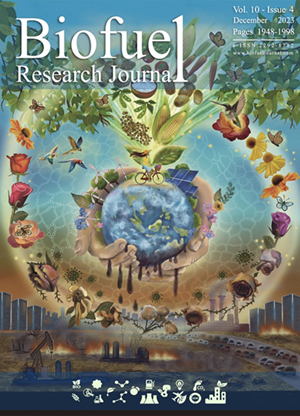不同硅铝比酸活化沸石对生物油的加氢脱氧
IF 14.4
Q1 ENERGY & FUELS
引用次数: 6
摘要
生物油中含有大量的氧分子,这可能会导致成分不稳定,降低其物理化学品质。为了抵消这一点,该组分必须进行氢化脱氧(HDO)反应。由于酸性活性位点的存在,沸石已被证明具有较高的加氢和脱氧能力。但天然沸石杂质较多,酸性密度低。因此,在用作HDO催化剂之前,需要进行预处理,如制备和活化。在本研究中,使用的催化剂是一种活性天然沸石,在用3、5和7 M盐酸脱铝后,用氮气流(分别指定为Z3、Z5和Z7)煅烧后,其酸度随Si/Al比而变化。结果表明,沸石的脱铝和煅烧一般会引起沸石物理特性和组分的变化。Z5催化剂在生物油HDO过程中表现出最好的催化性能。生物油的高热值(HHV)从12 MJ/kg提高到18 MJ/kg,粘度值增加了一倍,脱氧程度提高到77%,含水量大幅降低到生物油原液的1 / 3左右。此外,羧酸等对照化合物的含量略有下降,但苯酚的含量增加到原料生物油含量的两倍左右。本文章由计算机程序翻译,如有差异,请以英文原文为准。
Bio-oil hydrodeoxygenation over acid activated-zeolite with different Si/Al ratio
Bio-oil includes significant levels of oxygenate molecules, which might induce component instability and reduce its physicochemical qualities. To counteract this, the component must undergo a hydrodeoxygenation (HDO) reaction. Due to the presence of acidic active sites, zeolites have been shown to have high hydrogenation and deoxygenation capabilities. However, natural zeolite has a large number of impurities and low acidity density. Consequently, before being employed as an HDO catalyst, pretreatments such as preparation and activation are required. In this study, the catalyst used was an active natural zeolite whose acidity level varied depending on the Si/Al ratio after dealumination with 3, 5, and 7 M hydrochloric acid, proceeded by calcination with nitrogen gas flow (designated as Z3, Z5, and Z7, respectively). The results showed that dealumination and calcination of zeolite generally caused changes in its physical characteristics and components. The Z5 catalyst showed the best catalytic performance in the HDO process of bio-oil. The higher heating value (HHV) of bio-oil increased from 12 to 18 MJ/kg, the viscosity value doubled, the degree of deoxygenation increased to 77%, and the water content reduced dramatically to about one-third of that of raw bio-oil. Moreover, control compounds, such as carboxylic acids, decreased slightly, but the amount of phenol increased to about twice the content in raw bio-oil.
求助全文
通过发布文献求助,成功后即可免费获取论文全文。
去求助
来源期刊

Biofuel Research Journal-BRJ
ENERGY & FUELS-
CiteScore
22.10
自引率
1.50%
发文量
15
审稿时长
8 weeks
期刊介绍:
Biofuel Research Journal (BRJ) is a leading, peer-reviewed academic journal that focuses on high-quality research in the field of biofuels, bioproducts, and biomass-derived materials and technologies. The journal's primary goal is to contribute to the advancement of knowledge and understanding in the areas of sustainable energy solutions, environmental protection, and the circular economy. BRJ accepts various types of articles, including original research papers, review papers, case studies, short communications, and hypotheses. The specific areas covered by the journal include Biofuels and Bioproducts, Biomass Valorization, Biomass-Derived Materials for Energy and Storage Systems, Techno-Economic and Environmental Assessments, Climate Change and Sustainability, and Biofuels and Bioproducts in Circular Economy, among others. BRJ actively encourages interdisciplinary collaborations among researchers, engineers, scientists, policymakers, and industry experts to facilitate the adoption of sustainable energy solutions and promote a greener future. The journal maintains rigorous standards of peer review and editorial integrity to ensure that only impactful and high-quality research is published. Currently, BRJ is indexed by several prominent databases such as Web of Science, CAS Databases, Directory of Open Access Journals, Scimago Journal Rank, Scopus, Google Scholar, Elektronische Zeitschriftenbibliothek EZB, et al.
 求助内容:
求助内容: 应助结果提醒方式:
应助结果提醒方式:


